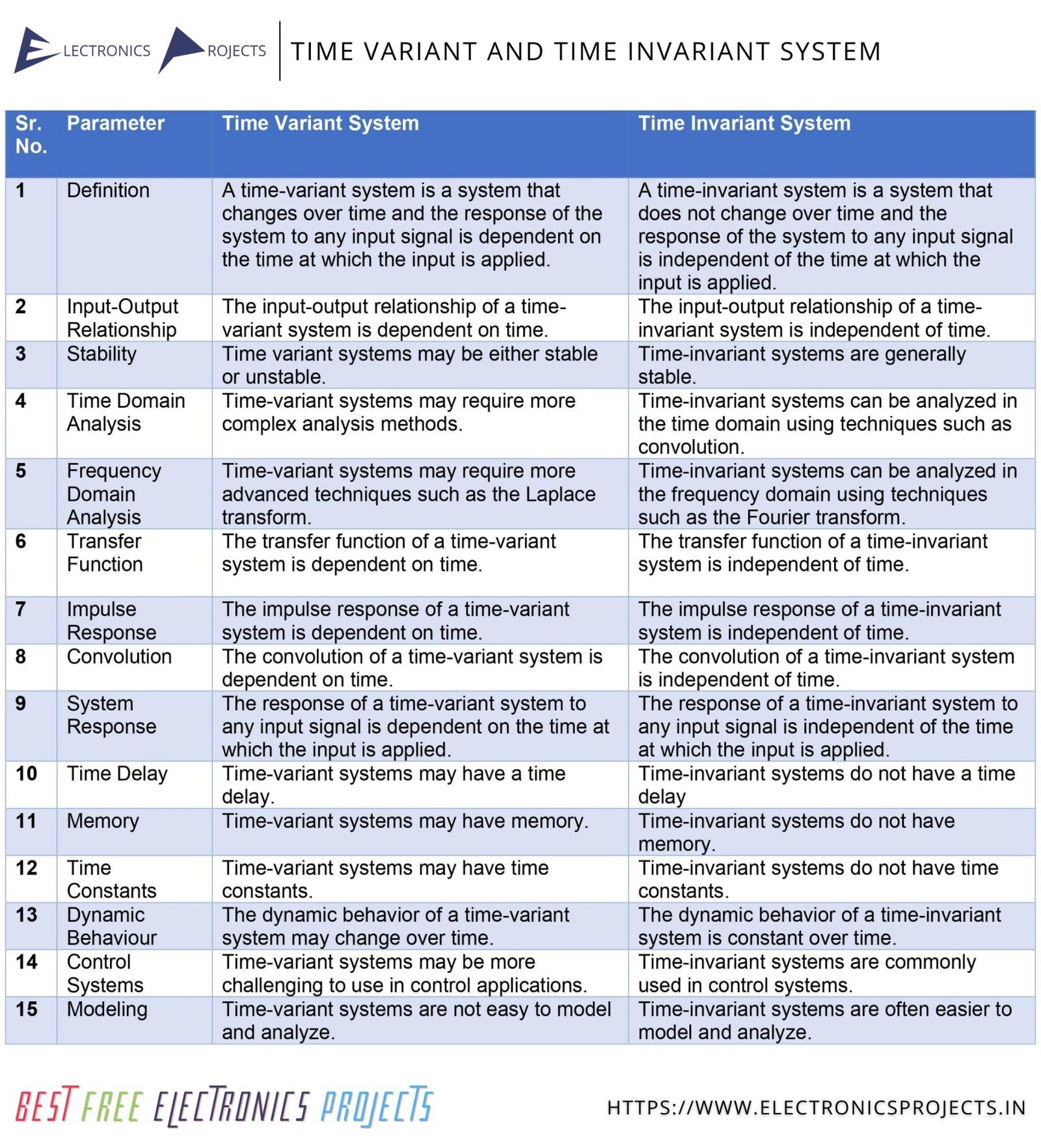What is Time Variant System?
A time-varying system is a system whose behavior changes over time. This means that the output of the system at a given time will depend not only on the current input to the system, but also on the previous inputs and the passage of time.
Time-varying systems can be described using a mathematical model known as a dynamic system model, which specifies how the system behaves over time in response to input signals. These models can take many different forms, including differential equations, difference equations, and state-space models.
Time-varying systems are often used to model physical systems that exhibit complex or time-dependent behavior, such as control systems, electronic circuits, and mechanical systems. They can exhibit a wide range of behaviors, including stability, oscillation, and instability.
Overall, time-varying systems are an important concept in the field of signals and systems because they provide a way to model and understand the behavior of systems that change over time in response to external inputs or internal processes.
What is Time Invariant System?
A time-invariant system is a system whose behavior does not change over time. This means that the output of the system at a given time will depend only on the current input to the system, and not on the previous inputs or the passage of time.
Time-invariant systems can be described using a mathematical model known as a static function, which maps an input signal to an output signal. These functions are typically represented using tables or graphs, which show the output of the system for different values of the input.
Time-invariant systems are often used to model simple physical systems, such as resistors in an electrical circuit or mechanical systems that are in equilibrium. They are relatively easy to analyze and design, as they do not exhibit time-dependent behavior.
Overall, time-invariant systems are an important concept in the field of signals and systems because they provide a simple way to model and understand the behavior of systems that do not change over time.
Difference between Time Variant and Time Invariant System:
Text Version:
| SR. NO. | PARAMETER | TIME VARIANT SYSTEM | TIME INVARIANT SYSTEM |
|---|---|---|---|
| 1 | Definition | A time-variant system is a system that changes over time and the response of the system to any input signal is dependent on the time at which the input is applied. | A time-invariant system is a system that does not change over time and the response of the system to any input signal is independent of the time at which the input is applied. |
| 2 | Input-Output Relationship | The input-output relationship of a time-variant system is dependent on time. | The input-output relationship of a time-invariant system is independent of time. |
| 3 | Stability | Time variant systems may be either stable or unstable. | Time-invariant systems are generally stable. |
| 4 | Time Domain Analysis | Time-variant systems may require more complex analysis methods. | Time-invariant systems can be analyzed in the time domain using techniques such as convolution. |
| 5 | Frequency Domain Analysis | Time-variant systems may require more advanced techniques such as the Laplace transform. | Time-invariant systems can be analyzed in the frequency domain using techniques such as the Fourier transform. |
| 6 | Transfer Function | The transfer function of a time-variant system is dependent on time. | The transfer function of a time-invariant system is independent of time. |
| 7 | Impulse Response | The impulse response of a time-variant system is dependent on time. | The impulse response of a time-invariant system is independent of time. |
| 8 | Convolution | The convolution of a time-variant system is dependent on time. | The convolution of a time-invariant system is independent of time. |
| 9 | System Response | The response of a time-variant system to any input signal is dependent on the time at which the input is applied. | The response of a time-invariant system to any input signal is independent of the time at which the input is applied. |
| 10 | Time Delay | Time-variant systems may have a time delay. | Time-invariant systems do not have a time delay. |
| 11 | Memory | Time-variant systems may have memory. | Time-invariant systems do not have memory. |
| 12 | Time Constants | Time-variant systems may have time constants. | Time-invariant systems do not have time constants. |
| 13 | Dynamic Behaviour | The dynamic behavior of a time-variant system may change over time. | The dynamic behavior of a time-invariant system is constant over time. |
| 14 | Control Systems | Time-variant systems may be more challenging to use in control applications. | Time-invariant systems are commonly used in control systems. |
| 15 | Modelling | Time-variant systems are not easy to model and analyze. | Time-invariant systems are often easier to model and analyze. |
Image Version:

Download above image in HD | Size: 1 MB | JPG Image
